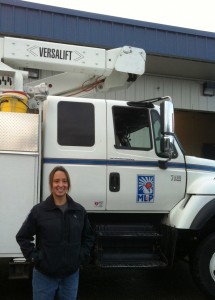Women in Alaska earn significantly less than men, and the YWCA is setting out to change that. Their new initiative aims to close the wage gap by 2025. One of the solutions may be simple–encourage more women to join the trades.
Deborah Kelly walks through the maze of buildings at ML&P in Anchorage, where she works.

“So this is the line shop. The barn,” she says as she walks into a cavernous garage. “We got all of our bucket trucks and some tree trimmers that work here as well.”
Kelly is a lineman, which means she fixes high voltage power and telephone lines. She opens a truck to show some of the gear she uses.
“So this what we actually use to climb the poles,” she explains as she pulls out a contraption that looks like an ancient leg brace attached to leather chaps.
“And there’s a small spike that is angled out and actually goes into the wood. And you just walk up the pole like you’re walking on the ground. Only different.”
“Seriously?” I ask, filled with doubt.
“Yeah, it’s great,” she smiles.
Kelly says she didn’t plan on working on power and phone lines, but when she tried it out during her apprenticeship with the IBEW, she instantly fell in love.
There was just one problem — she’s a woman.
“Well, I definitely had to prove to everybody why I was there and that I deserved to be in the trade. Because most guys have never worked with a woman and a lot of them have never even heard of a woman in the trade. I’m only the second one in the history of Alaska.”
The line trade is not the only industry where women are grossly under represented. State Department of Labor data shows few women work in natural resource development and construction as well, some of the highest paying jobs in the state. And state economists say that contributes to the overall gender pay gap.
The size of the pay gap depends on which data you look at. State estimates show that a woman only makes 67 cents for every dollar a man makes. The federal Bureau of Labor Statistics says women make 73 cents for every dollar.
YWCA of Alaska CEO Hilary Morgan says the gap is closing too slowly — only 5 cents in 20 years. “If we continue to do nothing at this rate, women and men will make equal pay in the year 2142, which is really not acceptable.”
Her organization is trying to close it by 2025 instead. But how? Morgan says she’s not exactly sure.
“When Kennedy said he was going to the moon he didn’t know how he was going to get there either, but he was going to get there,” she quips.
Morgan says the first step is changing societal norms — people need to stop accepting the pay gap as normal. The YWCA is partnering with other organizations and industries in Alaska to try to educate people on the discrepancy and to develop solutions. They’re also developing a tool to help businesses and organizations measure if they treat women differently.
“Many of them, their intent is not to pay their female employees less than their male employees. I think that just happens over time because people aren’t really looking at the issue.”
Back at ML&P, Kelly walks through the halls, joking with some of her colleagues.
“And, uh, don’t talk to this guy…”
A man puts on a jokingly serious face. “Trouble,” mutters at Kelly.
“Yeah, trouble,” she laughs. “Just pretend he wasn’t here.”
Kelly says she had to fight to get the same training as the men during her apprenticeship because her crew doubted her abilities and wanted to protect her because she’s small. She says she confronted sheer pig-headedness, too. The men didn’t understand what she was doing there.
But Kelly says the challenges were worth it.
“It’s the best job in the world. And skepticism and a few bad apples are not worth giving that up over.”
Kelly says she hopes to see other women doing what she does, and the sooner the better.
Anne Hillman is the healthy communities editor at Alaska Public Media and a host of Hometown, Alaska. Reach her atahillman@alaskapublic.org. Read more about Annehere.





